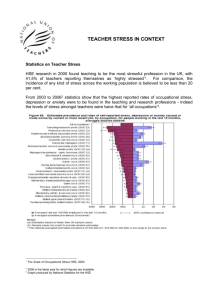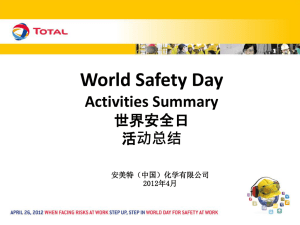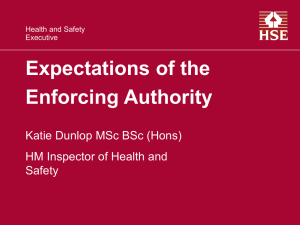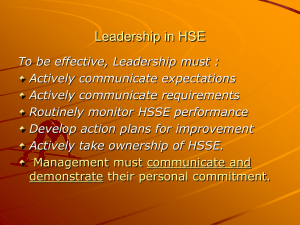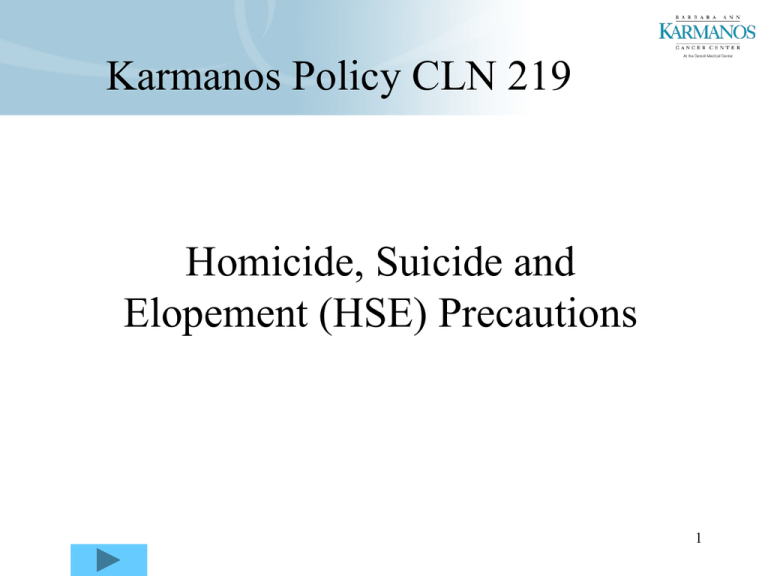
Karmanos Policy CLN 219
Homicide, Suicide and
Elopement (HSE) Precautions
1
Objective
• To identify and provide a safe environment for
patients at risk for homicide, suicide or elopement.
2
Screening
•
•
•
All patients are screened for the potential for
self-harm, and/or thoughts of hurting others on
admission.
Assessment information is documented on the
Adult Assessment History form.
Refer to the Adult Assessment History form and
observation of behavioral cues for identification
of high risk patients.
3
When to Consider the Potential
for Self Harm
• Consider the potential for self-harm or violence
toward others when the patient:
– Verbalizes intent or desire to hurt self/others
– Demonstrates aggressive behavior
4
Risk Factors
For Suicide Ideation or Behavior
• Suicidal ideation/behavior often occurs in patients
admitted to the general hospital who manifest
depressive symptoms.
5
Risk Factors
1. The presence of psychiatric illness.
• Strong predictors include depression or psychosis and/or
recent treatment for a psychiatric disorder, even though
florid symptoms may not be present.
2. The presence of a suicide plan with the intention and means to
carry out the plan.
3. The presence and/or history of a suicide attempt. The degree
of lethality and intention is most significant.
• The lethality should be assessed both in real terms as well
as the patient’s understanding of what was sufficient to be
lethal.
4. Patients who have attempted suicide are at a greater risk for
future attempts and/or successful suicide.
5. Expressions of a wish to die.
6. The presence of a family history of suicide.
6
Cancer Diagnosis Related
Risk Factors
•
•
•
•
Advanced stage of disease
Exhaustion or fatigue
Loss of control
Physical impairments
– Loss of mobility
– Incontinence
– Inability to eat or swallow
• Poor prognosis
• Uncontrolled pain
7
Complicating Factors
1. The presence of a recent loss (including death of a loved one,
divorce, separation, loss of a job, status, finances).
2. The presence of mental illness associated with pain and/or
disability.
3. The presence of alcohol/drug abuse.
4. The lack of adequate social supports (e.g., living alone, no
family).
5. The sex/age of the patient. In the general hospital patient
population, two groups appear to be particularly at risk:
•
•
Patients older than 70 years with chronic medical illness.
Patients aged between 20-30 years with concurrent psychiatric illness
and/or substance abuse.
6. Giving away cherished possessions.
8
Warning Signs that a Suicide Attempt
may be Imminent
•
•
•
•
•
Irritability
Increased anxiety
Agitation
Impulsivity
Decreased emotional
reactivity
• c/o unrelenting pain
• Refusing visitors
• Crying spells
• Refusing medications
• Decreased interest in
treatment or prognosis
• Feelings of
worthlessness
• Refusing to eat
9
What to do When a Patient
Shows Signs of HSE
•
Initiate HSE Precautions:
– Place patient under continuous visual
observation.
– Obtain Physician order for HSE precautions
within 8 hours of initiation.
– Obtain an order for STAT Psychiatry consult.
– Alert Security when HSE precautions are
ordered/discontinued.
– Consult Social Work.
10
Continuous Visual Observation
•
•
Visual observation of the patient must be
initiated immediately for patients at risk for selfharm or violence toward others.
Notify supervisor for assistance with reassigning a Patient Support Associate (PSA) or
Oncology Care Associate (OCA) to sit with the
patient.
11
Additionally
•
Patients on HSE precautions are not permitted to leave
the hospital prior to completion of treatment, Against
Medical Advice (AMA).
–
•
If/when patient is medically stable and HSE precautions
must continue, patient will be transferred to an
appropriate psychiatric facility.
–
•
Notify the attending physician of the patient’s request or
attempt.
If not medically stable, patient must remain hospitalized until
medically stable for transfer.
Psychiatry is responsible for discontinuation of HSE
precautions.
12
Interventions
•
The patient is to be assessed by Psychiatry
and interventions may include:
–
–
–
–
Environmental restrictions
Patient Safety Associate (Sitter)
Use of physical restraints (in an emergent
situation (CLN 012)
Or combination of the above
13
Attempt to Maintain Patient’s
Privacy & Security
•
Conduct search of area and personal search upon
initiation of the HSE precautions (notify Security if
assistance is required) (patient/family/staff safety
overrides patients’ right to privacy)
– Educate patient/family/visitors of potentially harmful
gifts/articles/personal items
– Remove hazardous articles, send home with family or
keep in patients’ property
– Remove all potentially harmful medical care
equipment and supplies after use
– Notify Nutritional Services to prohibit glass, metal
utensils, cans and metal trays
14
In the Event of Patient Elopement
•
•
•
•
•
Immediately notify Security
RN notifies the physician, nurse manager/designee
RN documents in medical record the efforts to locate the
patient
Clinical Manager/Director/Administrative Supervisor
notifies the Administrator On-Call
If unable to notify the family by telephone, the Clinical
Manager/Director/Administrative Supervisor will send a
telegram to the individual listed at “Notify in Case of
Emergency” in the medical record to contact the hospital
immediately and notify Risk Management.
15
Required Documentation
Every 12 hours in the Progress Note
• An objective description of the patient's behavior or
verbalizations
• The type(s) of HSE interventions in use and if a
Patient Safety Associate is present, include their
name, title, and time services provided.
• The reason for initiation or discontinuance of HSE
Precautions.
• Note: If the patient is restrained, the above
documentation may be incorporated in the
documentation required for the use of restraints on
the Restraint Flow Record.
16
Summary
• We hope this Computer Based Learning course
has been both informative and helpful. Feel free to
review this course until you are confident about
your knowledge of the material presented.
• Click the Take Test button on the when you are ready to
complete the requirements for this course.
• Click on the My Records button to return to your CBL
Courses to Complete list.
• Click the Exit button on the left to close the Student
Interface.
• References: Karmanos Policy CLN 219
17


